Many families usually make plans to put up their Christmas tree this time of year. But when’s the last time anything seemed normal?
Like so many other goods right now, the supply chain problems slowing down the delivery of so many products affect Christmas trees. Whether you prefer a real Christmas tree or an artificial Christmas tree, it’s more complicated and more expensive in 2021.
For California residents – and most people in Western states – the supply chain issues combine with inventory destroyed by western wildfires in tree-growing states like Oregon. Rising temperatures also create problems for tree farmers. The result: tree costs are up about five to ten percent.
The National Christmas Tree Association conducts an annual consumer survey every year, but due to the unique nature of 2020 amid the pandemic, buying behavior couldn’t be compared to previous years. Real Christmas tree buyers in 2020 were younger, more urban, and purchased more trees online than in previous years. All are brand new trends in this industry. Will they last? The average age of real tree buyers in 2020 was 38; this is four years younger than the average age of real tree buyers in 2019.
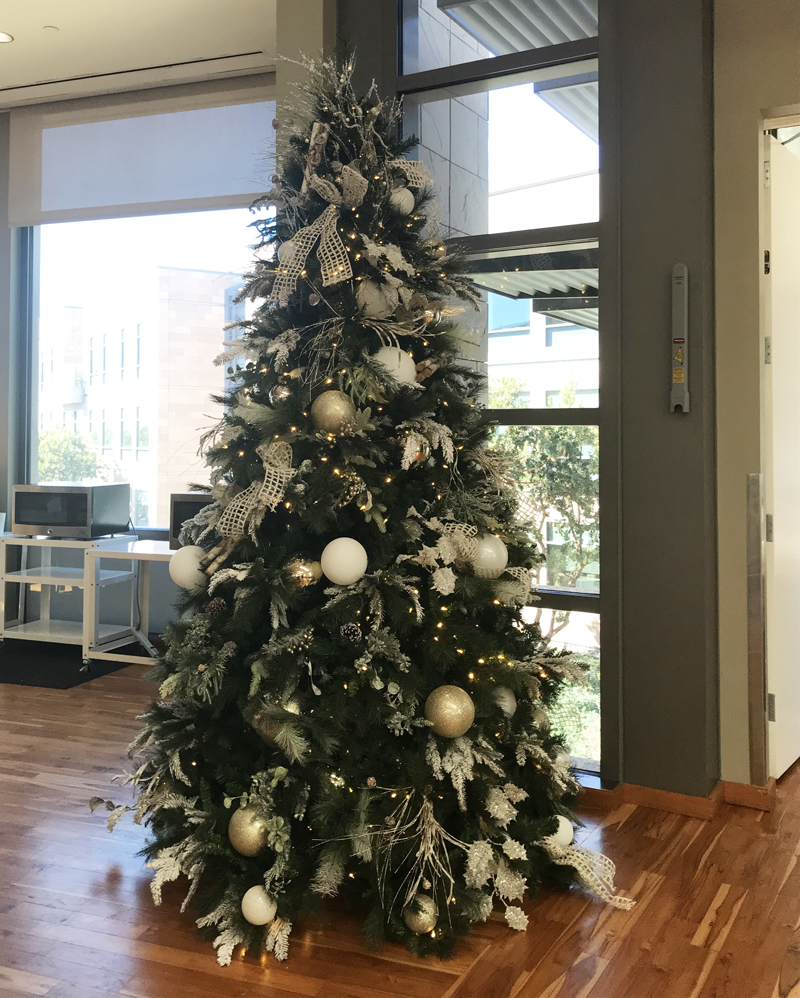
The Christmas tree created for our client Illumina in 2020.
We’d like to think it was driven by environmental responsibility, or perhaps it’s a sign of biophilic behavior – the innate human urge to connect with Nature. Locked into our homes without family and friends, it’s harder to do. Solution: A real Christmas tree! Nearly 40 percent of all real Christmas trees were purchased by urban area residents in 2020 – an eight percent increase over 2019.
The more critical issue for us at Good Earth Plant Company is figuring out which type of tree has less impact on our environment in the long run. Like a lot of decisions in life, it’s complicated.
I recently learned where artificial Christmas trees originated. They have only been in use for a few decades. Before that, a natural pine or fir tree was the only option available if you wanted a Christmas tree. It changed when American toilet bowl brush manufacturer Addis Brush Company created an artificial tree from brush bristles in the 1930s. Yes, I’m telling you the first artificial Christmas trees were big toilet brushes. Try not to think about THIS when you see your next artificial Christmas tree!
In Southern California, there is a significant issue for us to factor in: our ongoing drought. Despite the welcome rain in San Diego County this week, California is in its eighth year of a severe drought with no end in sight.
Oil and water
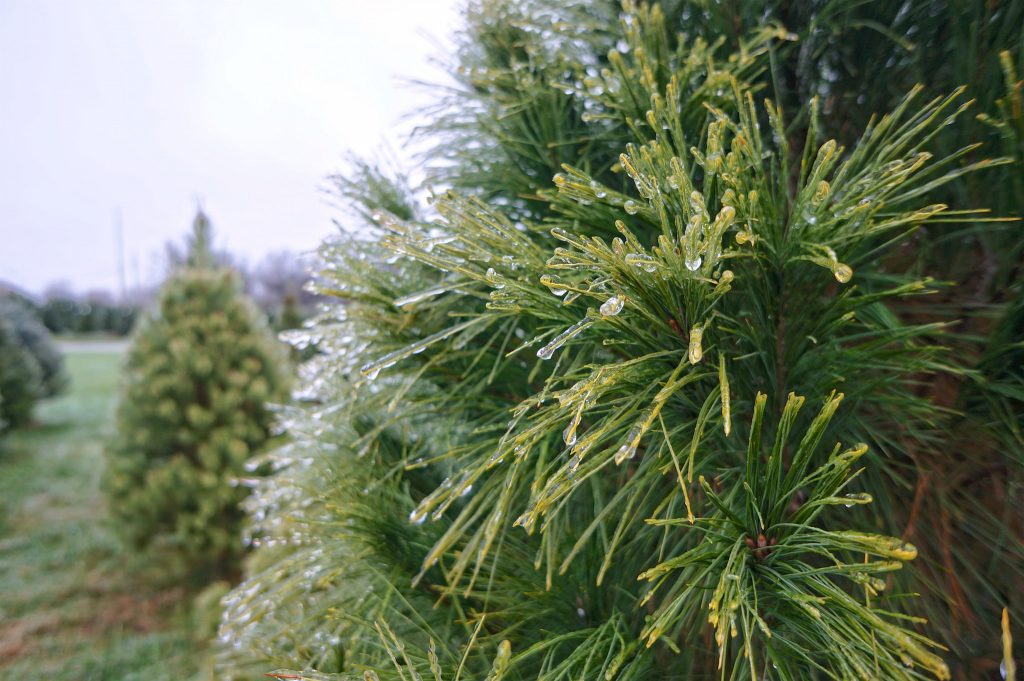
The average Christmas tree grows for six to eight years before it shows up in your home. Photo: Brent Flanders/Creative Commons
The average Christmas tree grows for six to eight years before it reaches the typical six to seven-foot height for cutting and display. This represents thousands of gallons of water per tree. Based on this information, artificial trees are more eco-friendly, right?
Not so fast. Eighty percent of all artificial trees sold in the United States are made in China. Most are made from metal and PVC, a petroleum-based plastic product. Petroleum, as in fossil fuels. Those trees come to the United States on container ships to West Coast and East Coast ports — when those ships can even get into port. As a result, ships are burning a much higher amount of fossil fuel anchored in place waiting outside Los Angeles and Long Beach ports. You may have also read in business reports the cost of containers has skyrocketed. A container that used to cost $3,000 now costs $18,000. You know who will have to absorb the cost: you!
When artificial trees finally arrive, they are placed on delivery trucks for distribution to the U.S. Even if we assume thousands of trees are in each cargo container. It takes many gallons of fuel per tree to get from the factory to your favorite spot in the living room.
You don’t have to buy a new artificial tree every year. On average, most consumers keep their trees for ten years. So for every year you buy a tree, there are nine years in between with no additional environmental impact.
Which trees have the bigger carbon footprint?
In some parts of the country, the Christmas tree in your living room was trucked hundreds or thousands of miles to reach your local Christmas tree lot after already traveling across the Pacific Ocean, which means the use of fossil fuels and other negative impacts of transportation apply to your real tree, too. Add it up times ten, and which is worse?
Christmas trees absorb carbon dioxide from the air during their production and produce oxygen. But they may require applications of pesticides, herbicides, and fertilizers. The ideal tree would be raised organically with integrated pest management, but this is rare.
The Montreal-based consulting firm Ellipsos tried to settle this question in a study. It found that artificial trees have a carbon footprint of 17.6 pounds of CO2 per year, compared to 6.84 pounds per year for a real tree.
Not so fast, though. This assumes keeping your artificial tree for six years, AND based on driving three miles or less to get your real tree. If you keep your artificial tree longer and drive more than 10 miles total to get your real tree, the numbers reverse, and the artificial tree is the winner.
People who buy artificial trees argue the environmental aspect, but the single most popular reason is the convenience: no watering needed, no messy needles all over the floor, and no need to drag it out to the curb for recycling later.
Real trees are in the lead
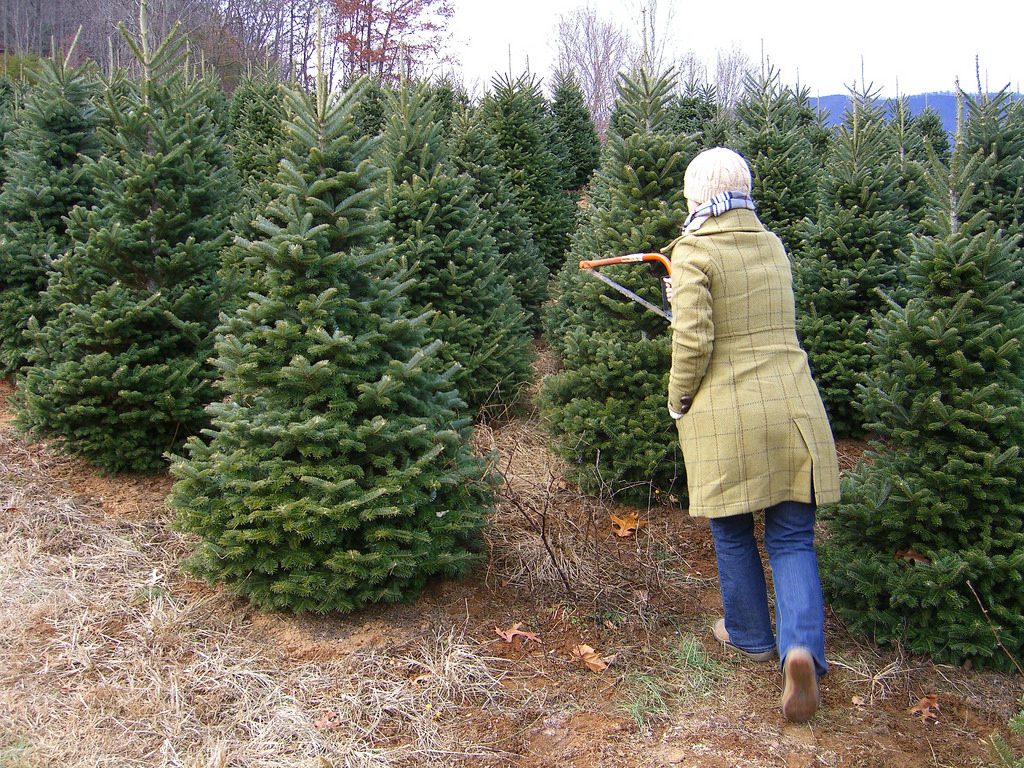
Christmas tree farm in North Carolina, second only to Oregon in the U.S. for Christmas tree growing. Photo Patrick Beeson/Creative Commons
The artificial tree squad is losing so far. Real Christmas trees are still the more popular choice. Americans purchased 27.4 million real Christmas trees in 2017 according to the National Christmas Tree Association, versus 21 million artificial trees.
Now brace yourself: A 2021 U.S. Department of Agriculture report showed live tree costs have nearly doubled compared to 2015 prices. Artificial Christmas tree retailers have reported raising prices by 20-30% this season. The average price of a live tree is now $80. The average price of an artificial tree is reported to be $100, but you can easily spend $1,000 for a high-end replica Christmas tree.
One-quarter of all real trees came from a “choose and cut” farm, where you pick your own tree and chop it down to take it home. Another quarter buy their tree at a large chain store.
Twenty percent come from a temporary retail lot. Fifteen percent come from a nursery or garden center. Ten percent are sold by a nonprofit organization. About 310 thousand acres are in production to grow Christmas trees in the U.S., with 310 million trees growing at any given time. One hundred thousand people are employed in the Christmas tree industry.
The top Christmas tree-producing states are Oregon, North Carolina, Michigan, Pennsylvania, Wisconsin, and Washington State. One out of every three real Christmas trees in the U.S. is grown in Oregon. Only a small fraction (109,000 total) are grown in California. So we can set aside the drought argument, score one for the real tree fans.
Ninety-three percent of real Christmas trees are successfully recycled into mulch used in landscaping, or chipped and used for playground materials, hiking trails, paths, and even beachfront erosion control. Artificial trees don’t biodegrade, so they will remain in a landfill for decades after you dispose of one.
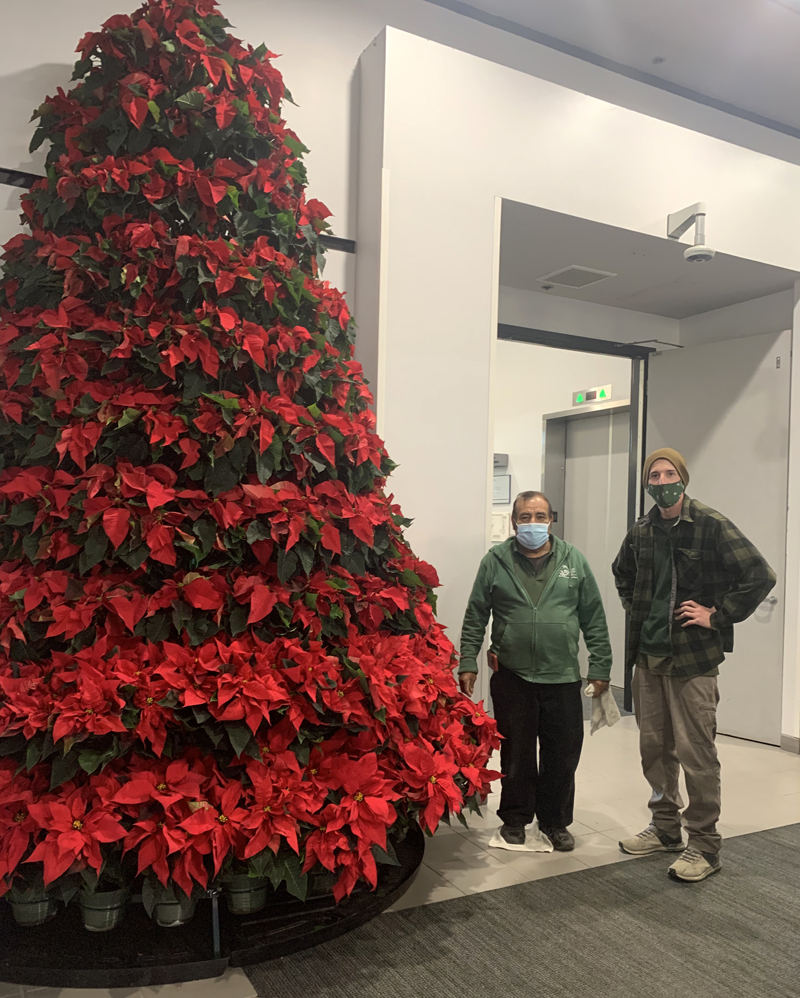
Good Earth Plant Company created our Living Giving Tree, made of individual poinsettia plants which can be given to employees, clients, or friends and families to enjoy. Photo: Good Earth Plant Company
Have we changed your mind about your choice of tree? Probably not based on the environmental aspect, since there are too many conflicting facts to make the choice obvious. That’s all right. This ongoing discussion is a net positive no matter what you decide. It’s a discussion we should all have about many of the items we purchase.
Every time you buy something – and we know you will be buying a LOT of stuff this time of year – it allows you to evaluate the environmental impact of your purchasing decisions. This includes the packaging and the shipping, too. Stopping to think about if it is healthy all year round.
Factor in fire safety
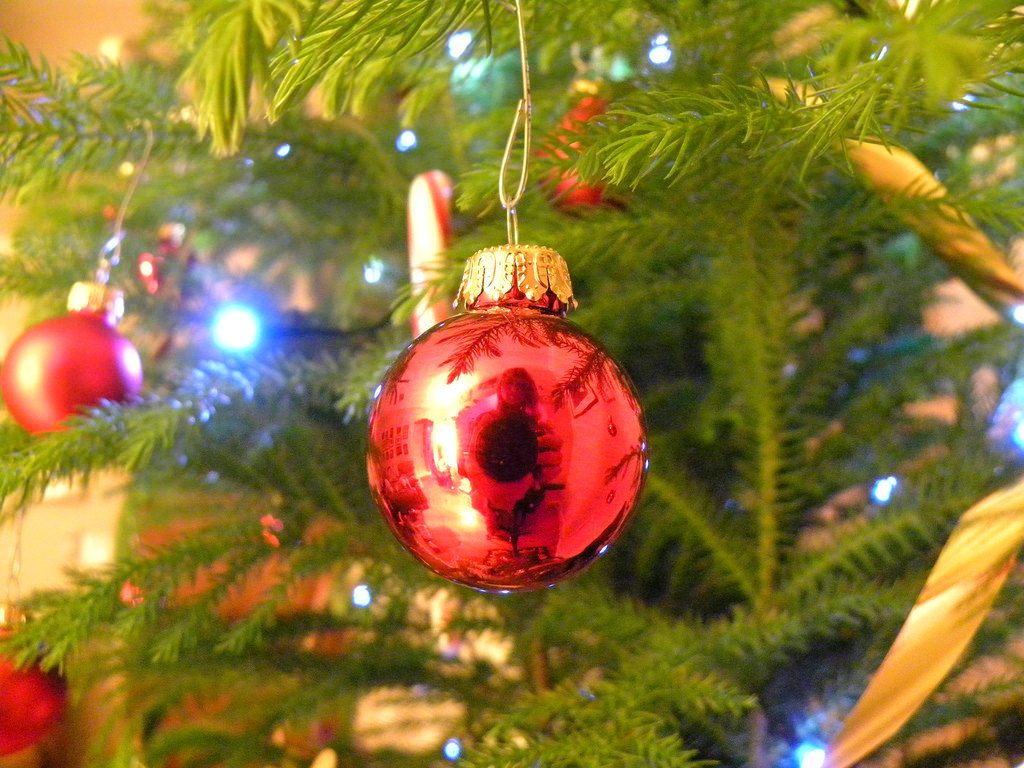
Real Christmas trees are beautiful – but they can also be flammable. Photo: Christina Ruggiero/Creative Commons
One crucial consideration we must bring to your attention is fire safety. Real Christmas trees can cause house fires every year, resulting in significant damage, injuries, and even deaths. People forget to water. They use the wrong lights. They put the tree too close to heating sources. Or all of the above.
According to the National Fire Protection Association, U.S. fire departments respond to an average of 230 home structure fires every year started by Christmas trees, causing six fatalities, two dozen injuries, and over $18 million in direct property damage. Admittedly 230 is a minimal number out of 26.5 million trees, but if it’s your home, one is too many.
Whichever you choose, take a moment to think about your motivation and your love for having a Christmas tree. It’s a plant, after all. People love plants due to their instinctive affinity for Nature. Plants make people happy. This is why we believe we have the best jobs in the world at Good Earth Plant Company. We enrich peoples’ lives with plants. You can do this with a poinsettia or a beautiful live arrangement of evergreens or flowers. Consider giving a living plant as a gift this holiday season. Then read our blog regularly for plant care tips. You’re welcome!

